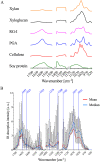Correlated mechanochemical maps of Arabidopsis thaliana primary cell walls using atomic force microscope infrared spectroscopy
- PMID: 37077971
- PMCID: PMC10095902
- DOI: 10.1017/qpb.2022.20
Correlated mechanochemical maps of Arabidopsis thaliana primary cell walls using atomic force microscope infrared spectroscopy
Abstract
Spatial heterogeneity in composition and organisation of the primary cell wall affects the mechanics of cellular morphogenesis. However, directly correlating cell wall composition, organisation and mechanics has been challenging. To overcome this barrier, we applied atomic force microscopy coupled with infrared (AFM-IR) spectroscopy to generate spatially correlated maps of chemical and mechanical properties for paraformaldehyde-fixed, intact Arabidopsis thaliana epidermal cell walls. AFM-IR spectra were deconvoluted by non-negative matrix factorisation (NMF) into a linear combination of IR spectral factors representing sets of chemical groups comprising different cell wall components. This approach enables quantification of chemical composition from IR spectral signatures and visualisation of chemical heterogeneity at nanometer resolution. Cross-correlation analysis of the spatial distribution of NMFs and mechanical properties suggests that the carbohydrate composition of cell wall junctions correlates with increased local stiffness. Together, our work establishes new methodology to use AFM-IR for the mechanochemical analysis of intact plant primary cell walls.
Keywords: atomic force microscopy; infrared spectroscopy; mechanochemical properties; plant cell wall.
© The Author(s) 2022.
Conflict of interest statement
The authors declare no conflicts of interest.
Figures










Similar articles
-
Mapping nano-scale mechanical heterogeneity of primary plant cell walls.J Exp Bot. 2016 Apr;67(9):2799-816. doi: 10.1093/jxb/erw117. Epub 2016 Mar 17. J Exp Bot. 2016. PMID: 26988718 Free PMC article.
-
Chemically characterizing the cortical cell nano-structure of human hair using atomic force microscopy integrated with infrared spectroscopy (AFM-IR).Int J Cosmet Sci. 2022 Feb;44(1):42-55. doi: 10.1111/ics.12753. Epub 2021 Dec 14. Int J Cosmet Sci. 2022. PMID: 34820858
-
Atomic force microscopy stiffness tomography on living Arabidopsis thaliana cells reveals the mechanical properties of surface and deep cell-wall layers during growth.Biophys J. 2012 Aug 8;103(3):386-394. doi: 10.1016/j.bpj.2012.06.046. Biophys J. 2012. PMID: 22947854 Free PMC article.
-
Heterogeneity in Mechanical Properties of Plant Cell Walls.Plants (Basel). 2024 Dec 20;13(24):3561. doi: 10.3390/plants13243561. Plants (Basel). 2024. PMID: 39771259 Free PMC article. Review.
-
Recent Progress on the Characterization of Cellulose Nanomaterials by Nanoscale Infrared Spectroscopy.Nanomaterials (Basel). 2021 May 20;11(5):1353. doi: 10.3390/nano11051353. Nanomaterials (Basel). 2021. PMID: 34065487 Free PMC article. Review.
Cited by
-
Spatial Distribution and Clustering of Glycosaminoglycans in Electrospun Gelatin-Based Scaffolds.ACS Omega. 2025 Jun 11;10(24):25405-25414. doi: 10.1021/acsomega.5c00604. eCollection 2025 Jun 24. ACS Omega. 2025. PMID: 40584385 Free PMC article.
References
LinkOut - more resources
Full Text Sources
Miscellaneous
